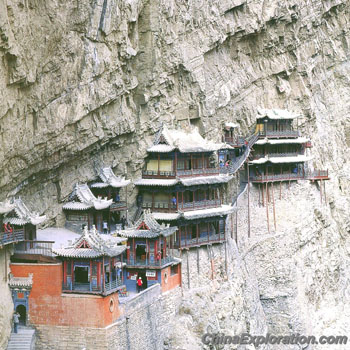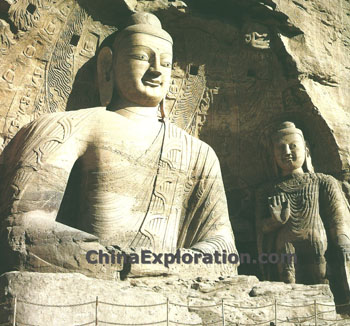search for a Trip
Introduction of Datong
 Datong is located in Shanxi Province, 379km (236 miles) west of Beijing, 284km (176 miles) Southeast of Hohhot, 350km (217 miles) north of Taiyuan. In 398, Datong (then Ping Cheng) became the capital of the Xianbei tribes' first Chinese-style state -- as opposed to a tribal confederation -- under the Northern Wei dynasty. Due to the long and splendid history, a lot of cultural and historical relics were left in Datong.
Datong is located in Shanxi Province, 379km (236 miles) west of Beijing, 284km (176 miles) Southeast of Hohhot, 350km (217 miles) north of Taiyuan. In 398, Datong (then Ping Cheng) became the capital of the Xianbei tribes' first Chinese-style state -- as opposed to a tribal confederation -- under the Northern Wei dynasty. Due to the long and splendid history, a lot of cultural and historical relics were left in Datong.
There are seven grottoes, 196 ancient architectures, 37 ancient ruins, 25 old tombs and 12 ancient steles according to the existing records and research. Among these, Yungang Caves, Huayan Temple, Nine-dragon Screen, Hanging Monastery and Yinxian wooden Pagoda are most famous. Modern Datong is an industrial center with an abundance of coal that is both a blessing and a curse. It's possible to visit Datong as a long day trip from Beijing, but to see all the sights, 2 days are needed.
Main attractions in Datong
Yungang Grottoes:
Located 16 kilometers (10 miles) west of Datong City, Yungang Grottoes is a complex of 45 grottoes carved into the cliffs of Wuzhou Mountain. It is a treasure trove of Buddhist carvings unrivaled in the world with a variety of more than 51,000 statues. Yungang Grottoes, together with Longmen Grottoes in Luoyang, Dunhuang Grottoes and Maijishan Grottoes in Gansu, are considered as the Four Greatest Buddha Grottoes in China. A range of caves wind a 1000-meter (3,280 feet) path with all sorts of Buddhist statues, continuous wall frescoes and intricate decorative cuttings. All these works present a blending result of both the traditional sculpture skills from China's early Qin (221 B.C.-206 B.C.) and Han (206 B.C. - 220 A.D) dynasties and the essence of Buddhist art at that time. It had a long-term influence on artistic development in the successive Sui (581 - 618) and Tang (618 - 907) dynasties.
- 907) dynasties.
Huayan Temple:
Located to the west of Datong City, Huayan Temple was one of the important temples for the Huayan Sect (one of the seven important Buddhist sects of China) during China's Liao Dynasty (916 - 1125) the sect found receptive popularity among the imperial courts. The original buildings served in part as the imperial ancestral temples but were destroyed in a fire. Rebuilt 1122 on a large scale with several extensions added during the Ming Dynasty (1368 - 1644) giving us the present complex.
Nine-Dragon Screen :
The Nine-Dragon Screen in Datong is reputed to be the largest of its kind in China with a long history of over 600 years. Originally built in 1392, it was the screening wall for a prince's mansion during the Ming Dynasty (1368 - 1644). The grand screen stands eight meters high (26 feet) to the south of Heyang Jie (Heyang Street) in the city and about 45 meters (148 feet) in length. Nine color-glazed flying dragons on the screen are composed of over 400 pieces of bright-colored glazed tiles in red, yellow, peacock blue, purple, and other overtones. The middle dragon is sitting on the axis of the mansion with other eight dragons flanked in pairs on each side. On the foundation of the screen, all sorts of sacred animals are represented, including elephant, tiger, lion, deer, horse, and kylin. The screen is listed as an important provincial relic site in Shanxi Province.
The Hanging Temple
The Hanging Monastery is 65 kilometers (40 miles) away from the city of Datong in Hunyuan County. It is a range of traditional Chinese temple buildings hanging on the cliffs of Jinlongxia (Golden Dragon Valley) of the famous Hengshan Mountain. it is reputed as Hanging Temple in Shanxi Province. The temple structures are constructed along a large concave cliff; the extrusive cliffs have sheltered the structures from the elements throughout the ages. Fifty meters (164 feet) high from the ground, these wooden-framed buildings seem to be 'hanging' along the steep cliffs like a piece of fine artwork against a natural screen. The buildings appear to be supported by only a dozen wood pillars. From the foot of the hill the viewing angle creates a more frightening sight!
Yinxian Wooden Pagoda:
Located in Yingxian County, about 70 kilometers (43 miles) from Datong, the six-storied wooden-frame pagoda boasts to be the greatest and the oldest of its kind in China. The octagonal pagoda is about 70 meters (230 feet) high and appears to consist of six stories. However, the interior of the pagoda has three hidden floors so in total it has nine stories. On each storey of the pagoda, twenty-four pillars in the outer circle support the octagonal eaves and another eight pillars further inside surround the interior body of the pagoda. The pillars are interwoven by a fine latticework of stanchions, beams, and puncheons. The construction of this well-proportioned pagoda used 3,000 cubes of wood at the weight of over 2,600 tons, and with no dowels or nails having being used. This presents the height of development in traditional Chinese wooden architecture of that period.
Datong Climate
|
Month |
Jan |
Feb |
Mar |
Apr |
May |
Jun |
Jul |
Aug |
Sep |
Oct |
Nov |
Dec |
|
Temperature (Celsius) |
-4.6 |
-2.2 |
5.5 |
15.1 |
18.8 |
24.0 |
27.8 |
30.4 |
21.4 |
15.4 |
8.1 |
-2.7 |
Click to see Datong tours
China Attractions Guide
- Anhui Attractions
- Beijing Attractions
- Chongqing Attractions
- Fujian Attractions
- Gansu Attractions
- Guangdong Attractions
- Guangxi Attractions
- Guizhou Attractions
- Hainan Attractions
- Henan Attractions
- Hongkong Attractions
- Hubei Attractions
- Hunan Attractions
- Inner Mongolia Attractions
- Jiangsu Attractions
- Jiangxi Attractions
- Manchuria Attractions
- Ningxia Attractions
- Qinghai Attractions
- Shaanxi Attractions


